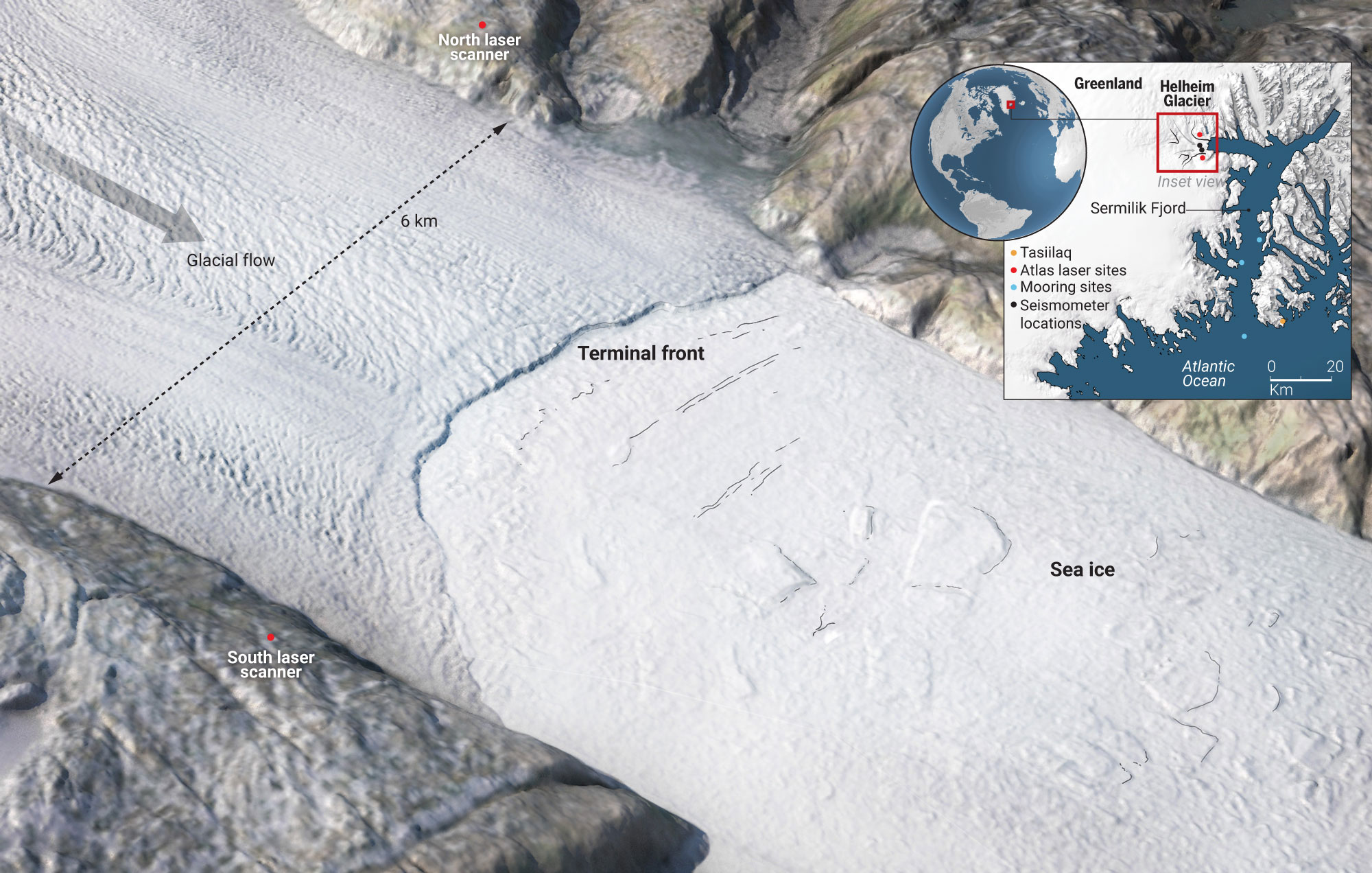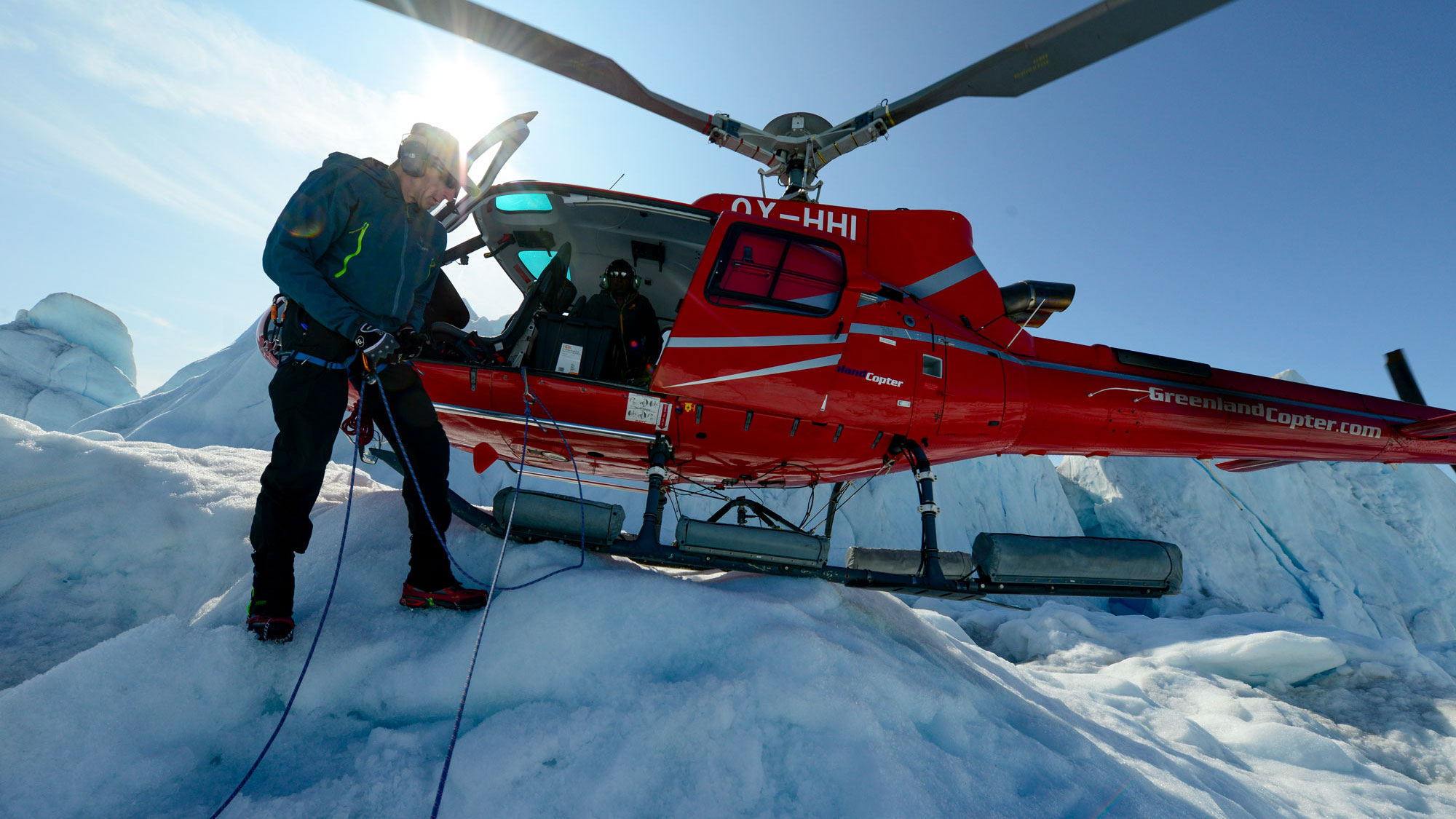THE 39-METER Jensen, a former Danish fisheries research ship and icebreaker, is far removed from large modern oceanographic ships, where scientists rarely get to touch an instrument. Its crew of five Greenlanders keeps it
running with a mix of grease, tobacco, and gumption. The scientists, too, have to improvise around limitations such as the Jensen's 1960s vintage winch. When the team retrieves the carousel, a gray cylindrical frame outfitted with
sensors and large sampling bottles, the winch is too feeble to hoist it on deck. That means an awkward transfer to the ship's crane.
It's just how the modest Straneo—who has had the same blue fleece since she was 18—likes it. "We still do oceanography the old-fashioned way," she says. "You kind of have to do everything yourself."
The Jensen had taken a back route from the port of Tasiilaq in southeastern Greenland, threading through narrow channels before sailing out into Sermilik Fjord. Peaks towered on both shores. A thin fog filtered cathedral light onto
glass-still water. To the west, the ice sheet bulked vast and gray behind the peaks. Icebergs, most calved by Helheim, were constant companions—some white, some sparkling blue, some sooty black—often dwarfing the Jensen as it steered
around them like a tugboat around an oil tanker. Every so often, the quiet was broken by the waterfall rush of violence as icebergs flipped over, agitated by the ship's wake.
Beyond collecting and placing long-term moorings, the team wanted to measure the salinity and temperature of the water column within the fjord, as far north as the ice would allow. The work has its hazards: One year, the ice was so thick on
the way to retrieve a mooring that the captain had a panic attack and turned back. A few days later, an iceberg destroyed that mooring. But Straneo was confident that the old icebreaker was up to the task.
After she could not retrieve the first mooring, three others came back with little drama, their spherical red-and-white floats popping up near the ship. Each mooring monitored a different depth to capture the Arctic-fed water near the
surface and the Atlantic layers beneath it. "It looks so easy when they come up," Straneo said. "And it's so painful when they don't."
After several days in Sermilik's midsection, the Jensen steamed closer to Helheim. The icebergs and their detritus grew denser, until the fjord seemed more ice than water. A mate climbed to the crow's nest to spot hazards, and the
Jensen began to plow through human-size bergs to avoid their larger cousins. Finally, the ice defeated the crew. Helheim's cliff face, some 25 kilometers away, loomed into view for a few minutes before a fairy-castle iceberg obscured
it.
The approach was close for Straneo, but it still left a large gap in her data. This year, other opportunities to fill it would come along. Her collaborators would launch a long-lived drifter that can navigate beneath sea ice. And, after the
cruise, Straneo's team planned to take a helicopter out to the open pool and drop sensors straight into the plume of meltwater.
EVEN AS THE Jensen navigated the fjord, two teams monitored the glacier itself. Near its front, Finnegan and the CRREL scientists tended to the autonomous Atlas lasers, one mounted on each side of the fjord. The researchers had
also agreed to help Sridhar Anandakrishnan, a glacial seismologist at Pennsylvania State University in State College, deploy 15 small seismometers, called geopebbles, on the glacier just behind the calving front—a feat possible only from the
air.
After a career working in Antarctica, it was Anandakrishnan's first experiment in Greenland. In the helicopter, his eyes widened on seeing the glacier. It was nothing like the flat, solid marine glaciers in Antarctica. Helheim was gouged
with crevasses some 20 to 30 meters deep; its southern flank was such a crumpled mess that it was hard to tell where the glacier stopped and sea ice began. "It's so spectacular," he said. "It's so scary."
Over and over that day, the helicopter pilot descended to within centimeters of the cracked ice. Two tethered CRREL researchers hopped out. They drilled a hole, dropped in a geopebble handed to them by Anandakrishnan, and marked it with an
orange flag. The devices would capture the seismic signals that shudder through the ice as it fractures—data that Anandakrishnan hoped to assemble into a 3D image of the underice channels that carry meltwater from its surface to the sea. The
water "collects just like any river into larger and larger streams," he says, "until you have the Nile running down the bottom of Helheim."
First, Anandakrishnan needed to see whether his geopebbles worked. They were designed to transmit wirelessly so that a hovering drone could harvest their data. Two days after inserting the instruments, he and Marc Volpe, a gangly aerospace
engineering student, took their homegrown drone out for a test flight. It looked the part: Two plastic pipes with a rotor on each end were strapped to a central metal axis about as long as a hockey stick. The landing gear was made of plastic
foam.
The first few short test flights, launched from as close to the glacier as they could safely go, ended in a crash, or what Volpe called "an unintended rapid reconfiguration." The drone's simplicity meant it could be rebuilt, and by late
morning of their second day, they were ready to send it out over the ice. "All clear," Anandakrishnan said. "No children or polar bears." But after skimming more than 1 kilometer over Helheim, the drone began to spin like a drunk, and they
nearly lost it before the radio signal returned and they called it back.
Finally, the day waning, Anandakrishnan asked Volpe whether he wanted to try again. "It's not your drone, it's not your money," Anandakrishnan said. "Want to go for it?"
"Yeah, I think so," Volpe said.
The drone again started to fly sideways—but in the right direction. One kilometer passed. Two. "Come on!" Anandakrishnan yelled. Three kilometers. "Holy crap, it's there!" Volpe said. The drone hovered for a minute
over the seismometer and then darted back toward home. "Did it connect to the pebble?" Volpe asked. Not only did it connect, Anandakrishnan said with glee, but "we got a big chunk of data."







